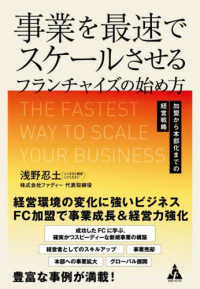Full Description
The APA Handbook of Human Systems Integration is a practical tool for both students and professionals who need specific knowledge about human considerations in systems design. It is intended to sensitize readers to basic design issues, enhance their understanding of the influence of these issues, and guide them in appropriately combining human performance with a system's numerous interacting components.
A central tenet of this book is that it is not sufficient to examine items independently - one must go beyond a focus on individual workers, tools, tasks, or environments. Thus, the handbook is a amp quot how to amp quot resource that reflects the state-of-the-art on work in this enterprise.
The book's opening chapters define what is meant by human systems integration, provide a historical overview of the field, and describe a set of case studies to which many chapter authors apply their expertise.
Succeeding chapters reflect on the physical, physiological, perceptual, cognitive, and organizational considerations that affect human systems performance and discuss how the knowledge base of the field has been applied in various domains.
The remaining chapters describe the trade-offs associated with integrating individual considerations and systems performance, discussing how a decision that optimizes performance in one area (e.g., display design) may entail a reduction of performance in another area (e.g., staffing or personnel selection).
Contents
Editorial Board
About the Editors-in-Chief
Contributors
Reviewers
Series Preface
Introduction
I. Definition and HistorySection : Definitions of Human Systems Integration
A View of Human Systems Integration From the Academy
Francis T. Durso, Deborah A. Boehm-Davis, and John D. Lee
Systems Engineering Perspective on Human Systems Integration
Dennis J. Folds
Human Systems Integration in the Military
Michael Drillings, Beverly Knapp, and Nita Lewis Shattuck
Case Studies
Deborah A. Boehm-Davis and Nancy J. Cooke
Section 2: Perspectives on Human Systems Integration
Human Systems Integration Requirements Analysis
Mica R. Endsley
Specifying System Requirements Using Cognitive Work Analysis
Neville A. Stanton and Rich C. McIlroy
Applications of Systems Engineering for Testing and Evaluation: A Human Systems Integration Perspective
Tareq Ahram, Waldemar Karwowski, and Christianne Falc amp atilde o
II. Considerations Affecting Human Systems PerformanceSection : Physical and Physiological Considerations
Anthropometry in Human Systems Integration
Bruce Bradtmiller
Digital Modeling of Physical Constraints
D. Reuben Haupt and Matthew B. Parkinson
Strength, Endurance, and Movement
Tyson Grier, Bradley C. Nindl, and Bruce H. Jones
Neuroergonomic Perspectives on Human Systems Integration: Mental Workload, Vigilance, Adaptive Automation, and Training
Raja Parasuraman
Integration of Sleep Need and Fatigue Mitigation Into Human Systems Operation
Takashi Abe, Namni Goel, Mathias Basner, Daniel Mollicone, Hengyi Rao, and David F. Dinges
Environmental Conditions and Physical Stressors
Elizabeth S. Redden and Gabriella Brick Larkin
Slips and Falls
Thurmon Lockhart
Section 2: Perceptual and Cognitive Considerations
Basics of Sensation and Perception With an Eye Toward Application
Patricia R. DeLucia and Samuel J. Levulis
Auditory Perception
Carryl L. Baldwin
Attention and Multitasking
Roger W. Remington and Shayne Loft
Workload
Chris Wickens and Pamela S. Tsang
Situation Awareness in Human Systems Integration
Kim-Phuong L. Vu and Dan Chiappe
Decision Making and Human Systems Integration
Ann M. Bisantz and Emilie M. Roth
Augmented Cognition
Kay Stanney, Brent Winslow, Kelly Hale, and Dylan Schmorrow
Human Performance Modeling
Michael D. Byrne
Section 3: System-Level Constraints
Political and Social Considerations in Human Systems Integration
Raymond S. Nickerson
The Economics of Human Systems Integration
William B. Rouse
III. Applying Considerations Affecting Performance to DesignSection : Displays and Controls
Visuospatial Displays: Design Problems and Principles
C. Melody Carswell and Will Seidelman
Enhancing Creative Problem Solving Through Visual Display Design
Kevin B. Bennett, John M. Flach, Timothy R. McEwen, and Olivia Fox
Multisensory Information Processing
Charles Spence and Cristy Ho
Automation
Thomas B. Sheridan
Section 2: Personnel
The Manpower Determination Process
Daniel F. Wallace, James J. McTigue, and Laurie J. Van Buskirk
Personnel Selection: A Primer
Daniel B. Shore, Zitong Sheng, Jose M. Cortina, and Maya Yankelevich Garza
The Training Process: Using the Science Each Step of the Way
Rebecca Grossman, James Oglesby, and Eduardo Salas
Motivation
Jeffrey B. Vancouver
The Implications of Aging for Human Systems Integration
Daniel G. Morrow and Sara J. Czaja
Section 3: Teams and Organizations
Teams, Teamwork, and Team Effectiveness: Implications for Human Systems Integration
Steve W. J. Kozlowski, James A. Grand, Samantha K. Baard, and Marina Pearce
Organizational Design: Macroergonomics as a Foundation for Human Systems Integration
Pascale Carayon, Sarah Kianfar, Yaqiong Li, and Abigail Wooldridge
Organizational Culture
Mark Fleming and Frank Guldenmund
Index








